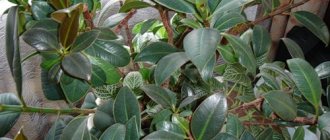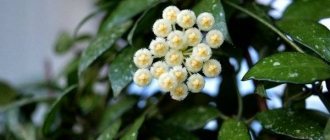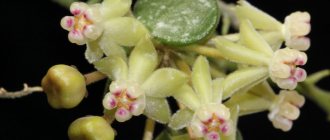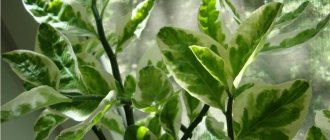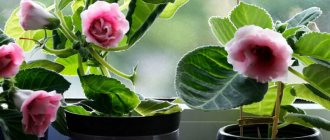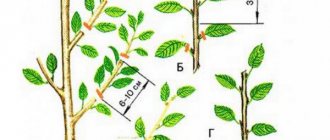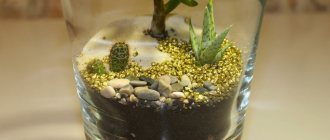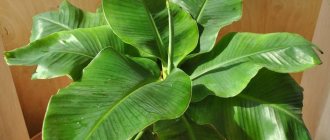Amateur gardeners can often see an interesting flower on their windowsill, something between an aloe and a cactus. This is a small, fleshy, sometimes brightly and strangely colored plant - Haworthia, an alien and guest in our latitudes. The name, which sounds so unusual, was given to the plant in honor of E.H. Haworth, a renowned biologist and researcher with a special interest in succulents.
The fleshy leaves vary so much from species to species that you don’t always recognize the plant right away. And yet each species has its own charm. The diversity and metamorphoses of the flower are very attractive, I want to know more about it.
Description
Haworthia belongs to the Asphodelaceae family, subfamily Asphodelaceae. These are monocotyledonous plants capable of flowering, belonging to the order Asparagales.
They are succulents: squat, medium-sized plants with fleshy, succulent leaves collected in a rosette. The leaves are quite intricately structured, due to white tubercles or colorless transparent areas of “windows”.
There are stem species, but their stems are very short, they are almost invisible due to the thick leaves closely arranged in a circle.
The plant blooms, as a rule, very inconspicuously, with white or indistinct greenish small flowers.
Haworthia came to us from South Africa. It has several of the same unusual names (Gavortia, Gavortia), and due to the similarity of some species to the bush, the scarlet plant is often called “dwarf scarlet.”
Biologists divide the Haworthia species into three subspecies, but the famous flower expert Valery Zlotin believes that it is more correct to distinguish five groups:
1. “Aloe-like”, which includes such common species in our country as:
- chloracantha,
- cooperi,
- limifolia,
- fasciata
- tesselata,
and also much rarer ones:
- koelmaniorum,
- pumila,
- marumiana and others.
2. “Columnar” - very popular among us H. reinwardtii, quite widely known H. armstrongii, H. coarctata, H. viscosa, as well as H. glauca and the very rare H. nigra. These species have a low stem tightly wrapped in a spiral with fleshy leaves.
3. “Flat” - exceptionally beautiful plants with flat-cut (“blunted”) leaves, usually having transparent windows. In nature, these plants are often completely submerged in the soil, with only flat areas of leaves coming to the surface. The most common species in our collections is H. truncata, a miniature masterpiece of nature. This plant has the shape not of a rosette, but of a fan, or an open book. You can also find H. retusa. However, many beautiful species are almost unknown in our country, such as:
- bayeri,
- comptoniana,
- emelyae,
- magnifica,
- maughanii,
- mirabilis,
- mutica,
- pygmea,
- springbokvlakensis and others.
4. “Lacy” - with cilia along the edges of the leaves, giving the plants a lacy appearance. This group includes H. arachnoidea with many varieties, H. bolusii, H. decipiens, H. lockwoodii, H. xiphiophylla and several others. Unfortunately, these wonderful species are practically never found here.
5. The last group is the “herbaceous” haworthia, which includes H. blackburniae, H. longiana and H. Wittebergensis. The leaves are long and thin. For example, H. blackburniae leaves, with a diameter of 3-5 mm, reach a length of about 40 cm.
Classification, family and homeland of the plant
Haworthia limifolia (lat. Haworthia limifolia) is a genus of succulents of the Asphodeloideae subfamily of the Xanthorrhoeaceae family. First described by the Englishman Adrian Haworth.
It grows in arid areas of South-West and South Africa, preferring shady places under bushes or in grass.
There are more than a hundred species in the genus. In nature, the height of plants reaches one meter, the growing season lasts more than 20 years.
Popular types
The most popular types of haworthias have long been decorating window sills of flower growers. Thanks to their miniature size, they can be grown in city apartments without thinking about the lack of space, and if you don’t spare time, you won’t be able to take your eyes off the variety of colors in the collection.
Haworthia navicularis
Haworthia navicularis
Haworthia cymbiformis has conquered the world thanks to its remarkable qualities - it is beautiful, easy to care for, and reproduces very easily. Even in a small pot (no more than 7 cm in diameter), the flower quickly produces shoots and children, and the children immediately come with roots. Thanks to this feature, the plant forms rather large clumps. The leaves of the flower are light green, wide at the bottom and sharply pointed at the top. The short leaves look like a rook. The flowers are small, white in color, form an inflorescence on a short peduncle. Haworthia navicularis is often called “Haworthia for beginners.”
Haworthia pearl
Haworthia pearl
Quite a common type. It has dark green leaves up to 7 cm long, about 2.0-2.5 cm wide. The edges of the leaves are dotted with short white spines. The bush resembles a green flower on which pearls have been scattered, hence the second name – “pearl-bearing”. Pale greenish flowers on a short peduncle are not at all interesting in appearance.
Haworthia striped
Haworthia striped
It is this variety that resembles aloe, but the diameter of the clump is smaller, up to 15 cm in diameter. Growths in the form of warts dot the lower part of the leaf, but the upper part is smooth, greenish-marsh in color. It shows all its decorative qualities only in bright light; in the shade it loses its decorative effect.
Haworthia retusa
Haworthia retusa variegata
This also applies to very popular varieties. Haworthia retusa is very interesting in appearance - on a dense basis there are many small (no more than 5 cm) triangular, bent back leaves. The color of the jackets is very diverse, there are even red varieties (to brown). Due to the many translucent “windows” the plant looks interesting and attractive.
Haworthia sinuous
Haworthia sinuous
This subspecies has a stem tightly “packed” with small succulent leaves in a spiral. The light leaves with a wide base seem to be slightly folded inward, the lower part is dotted with tiny white warts, the upper part is smooth. The plant looks interesting and very beautiful.
Haworthia limifolia
Haworthia limifolia
Haworthia limifolia, or tercolifolia, is very similar to pearly, but its leaves are much longer (up to 9 cm). The shape of the leaf is strongly pointed at the ends and a not particularly pronounced pattern, which is mainly inside the curtain. This makes limifolia unusual.
Haworthia mix
Haworthia mix
Despite its separate name, Haworthia mix is not a species, but a method of planting in a container. A collection of dwarf succulents planted together in one pot looks stunning and very decorative.
Haworthia reinwardta
Haworthia reinwardta
Tightly pressed to the stem, up to 12 cm high, the leaves form a very unusual plant shape. It looks like a spike or a braided braid. Large growths form in comfortable conditions and make the flower look gorgeous. It can throw out a very long peduncle with small flowers - stars.
Haworthia attenuata
Haworthia attenuata
Forms clumps of dense rosettes. Each rosette is formed by 30-35 leaves, quite long (up to 8 cm), but not wide. Young leaves tend upward, older leaves bend. The pattern on the surface of the leaves is very interesting, which distinguishes this subspecies from others: on the upper side of the leaf there are longitudinal lines of tubercles, on the lower side there are transverse lines. It blooms with tubular greenish flowers collected in a raceme.
Haworthia limofolia
Haworthia limofolia
This subspecies has a unique pattern: all warts merge into solid lines on both sides of the leaf, the resulting pattern is mirrored.
Botanical description with photo
- The plant forms rosettes of small fleshy leaves up to 12 cm in diameter.
- The leaves are straight, bluish-green, transparent at the tips with green or reddening veins. In most varieties, the leaf ends in long bristles. Haworthia accumulates liquid in its leaf blades.
- The stem is very short or completely absent.
- The inflorescence is compact, up to 20 cm long, with numerous white inconspicuous flowers.
- The root system is superficial.
Caring for Haworthia at home
The plant is unusually unpretentious and responds very gratefully to care at home, especially competent care.
The soil
It is quite possible to use purchased soil for succulents, but the plant will thank you for a high-quality substrate compiled independently.
To do this take:
- clay-turf soil – 1/3;
- leaf soil – 1/3;
- sand - 1/3.
Mix everything well and add a component that absorbs moisture and increases the looseness and porosity of the soil (for example, brick chips).
Lighting
In nature, the plant does not like open places scorched by the sun. In our latitudes, the flower will say “thank you” for a sunny place on the western and eastern windowsill. The twilight on the north side, if it does not destroy the haworthia, will completely deprive it of its decorative value.
Temperature
Low and too high temperatures are detrimental to the plant. There is nothing better than the “golden mean” with a temperature of +23...+25°C. In winter, it is better to lower the temperature to +12...+15°C, ensuring the flower rest.
Watering
Haworthia is drought-resistant. In conditions of a cramped pot, dry air in city apartments, the plant needs to be watered (once a week) with well-settled water at room temperature. The criterion is drying of the soil. It must not be over-watered.
In winter, haworthia is watered once a month with cool water.
Trimming
Pruning is not necessary. Carry out only to give the desired decorative shape and very carefully.
Transfer
The criterion for transplanting Haworthia is the size of the pot. The plant feels best in a round container. It is better to take a shallow, wide enough, squat pot.
Transfer order:
- Place drainage at the bottom of the pot.
- Cover the drainage with soil so that it is visually clear that the plant will be placed correctly.
- Place the haworthia in the middle.
- Sprinkle the soil so that the roots are completely covered (to the top level), water and lightly compact the soil.
- If necessary, add more soil.
You must work very carefully. If the root system is damaged, the plant may become sick and even die.
Feeding
Haworthia responds well to industrial fertilizer for cacti and succulents. If you make up your own fertilizer, you need to pay attention to phosphorus and potassium. Nitrogen is not the best macronutrient for these plants. It is better to apply all types of fertilizing in the summer.
Haworthia in winter
Like all similar types of succulents, it is better not to disturb the flower in winter. The best way to provide a plant with winter rest is to move it to a cool, not very bright place and water it occasionally. Watering once a month with cool (not higher than +14°C) water will allow the haworthia to emerge from the winter state with honor and please the owner with a chic appearance until the next winter.
Haworthia striped: signs and superstitions
There are many beliefs and signs associated with this unusual succulent. It is generally accepted that the plant improves the indoor microclimate and also clears the atmosphere of negativity . The leaves seem to absorb all the negative energy and convert it into oxygen.
Some experts argue that haworthia can serve as an indicator of intrafamily relationships. If a flower withers and gets sick, this means that problems are brewing in the family that require an urgent decision. In a house where love and understanding reign, haworthia grows and blooms. In this case, of course, do not forget about proper care!
Reproduction methods
Haworthia can be propagated in a number of simple ways.
Side shoots
To do this, carefully cut off a small shoot without roots, place it in a flat container with a damp substrate and provide a “greenhouse” for rooting. A similar method is reproduction by “children”. A daughter clump with small roots also takes root easily.
Leaf
Cut off the leaf and put it in a warm place for 48 – 72 hours to dry. Place the dried leaf in the sand, cover (make a “greenhouse”) for rooting. When the first roots appear, transplant the tiny haworthia into the soil.
Seeds
Surprisingly, it is quite possible to grow haworthia from seeds. For this:
- prepare special soil (for example: vermiculite, perlite, ceramis, sand, soil for succulents and dolomite flour (very little);
- place the substrate in wide and flat containers;
- press the seeds into the prepared substrate;
- cover the seeded containers with cling film;
- place the containers in a not very hot, semi-dark place;
- When seedlings appear, move the crops to bright light or provide lighting;
- if the seedlings are under artificial lighting, provide them with greenhouse conditions;
- dive carefully, after drying the soil.
Reproduction
Haworthia Cooper can be propagated by leaves, seeds or by planting babies. The seed method is considered the most difficult and time-consuming, so only breeders use it to develop new varieties.
The most accessible and simplest way is to separate and root the overgrown children or propagate by leaf. Children with roots (or without) are separated from the mother bush and planted in individual containers.
The leaves are cut off from the outside of the rosettes and dried for 1–2 days. The dried leaf blades are laid out on wet sand and covered with a plastic glass. After the roots appear, the shelter is removed.
Possible problems during cultivation
Unfortunately, despite their unpretentiousness, Haworthias can be capricious. For example:
- with excess or untimely application of fertilizers, the leaves change their natural color;
- if the temperature and humidity are too low, the leaves rot;
- at high temperatures and dry air (on a heavily heated windowsill) – the tips of the leaves dry out and curl;
- If the air is too humid, the leaves wither.
Proper care at home will allow you to enjoy the healthy appearance of this exotic and beautiful plant for a long time.
Description and photo of the plant
Haworthia Coopera is a dwarf, slow-growing succulent. At home, it grows to a maximum of 13 cm in height, and the diameter of the outlet can reach 10–15 cm.
The leaf blades are short, dense and fleshy. The color ranges from light green to dark green, and hybrid varieties boast colored leaves. The tips are transparent, slightly pointed or rounded. A colorless “window” can occupy the entire upper part of the leaf or run along the edge of the tip.
It allows the plant to absorb the required amount of sunlight. Like most succulents, Cooper's Haworthia accumulates moisture inside its leaves. The shape of the leaf plates is spherical, triangular, cuboid, rectangular or oval.
Photo source: www.sunnyplants.com
There are bristles along the edges of the leaf blades, and in some varieties a thread-like or bristly process is formed at the tip of the leaf.
Also read: Monilaria - bunny ears
There is no stem as such or it is weakly expressed. Therefore, depending on the species, the leaves can grow from a short stem or directly from the roots. The leaf blades form dense, spreading rosettes. The older the plant, the more growths and additional rosettes it has.
The flowering period occurs in late spring or early summer. Haworthia produces a long peduncle on which small, whitish buds form.
Diseases and pests
Shchitovka
It feeds on juice by piercing leaves and stems. A large number of pests can completely destroy the plant.
Mealybug
Mealybugs (hairy lice) are named for their white, cotton-like secretions. When this pest appears, the flower suffers and growth is completely retarded.
To control pests, it is necessary to treat the plant with insecticides. The best insecticides are “Aktara”, “Aktellik”, “Mospilan”. The treatment is carried out according to the instructions, twice. If the roots are damaged, it is necessary to remove the plant from the substrate, rinse the root system and dip the roots in the insecticide solution for several minutes. After treatment, transplant the plant into a new pot with fresh substrate.
If all the rules of agricultural technology are observed, beautiful haworthias will not only delight their owners with exquisite and varied beauty, but will also improve the psychological climate of the home. This guest from warm countries has amazing positive energy.
Classification and description of the genus of succulents Haworthia
Haworthia is a genus of succulent plants endemic to southern Africa. Belongs to the Asphodeloideae family. The first written records of Haworthia date back to the 1600s, when European colonists discovered new territories in southern Africa. The first to describe these low-growing plants was the British botanist Adrian Haworth. These succulents were subsequently named after him.
The variety of Haworthia forms is impressive.
After their discovery, Haworthia were included in the genus Aloe, but in the 19th century they were transferred to a separate genus of the family Asphodelaceae. In the 2010s, after genetic research, the genus Haworthia was divided into three separate genera: Haworthia (42 species), Haworthiopsis (18 species) and Tulista (4 species). There is still debate in scientific circles about the systematization of succulents of the genus Haworthia.
Many of the currently known varieties originated in Japan, since they were the first to cross different species of Haworthia. Today, hybrid varieties are created by many collectors around the world, as the popularity of these plants is growing every day.
Characteristics of plants of the genus Haworthia
Haworthia are low-growing plants, most species are characterized by low-growing rosettes of fleshy leaves. Many species of Haworthia are distinguished by their striking appearance and unusual shapes - from narrow leaves with black and white stripes, like a zebra, to transparent or translucent leaves. These small plants are memorable for their fleshy green leaves, generously covered with white “warts” or stripes that give them a distinctive appearance. In their natural habitat, these crops are quite difficult to find.
Photo of one of the Haworthia species in the South African desert
The desert plant Haworthia is a low-growing crop, the average height of the plant is 7-12 cm, the largest reach a height of about 50 cm. They are distinguished by fleshy, green leaves, often covered with white tubercles or stripes. Because of this feature of the foliage, these succulents are also called “Haworthia Zebra”. Leaves may have pointed, blunt or rounded tips. In some species the leaves may be hard and tough, while in others they are softer, leathery and translucent. These small succulents are very drought tolerant and do not require systematic care during the growing process. This makes them an excellent choice for growing indoors.
Flowers usually appear in the summer months at the end of a long stem (inflorescence) if they are properly cared for throughout the year. Haworthia flowers are not as colorful as the leaves, they are quite small and not as colorful. The flowers are usually double-tipped, small, tubular and attached to a long flower stalk, which may be simple or branched.
What kind of plant is this?
This plant does not have a stem. But it is characterized by a rosette consisting of linear and pointed vaginas. In appearance they resemble aloe leaves . The surface of the leaf is often dark green, it is rough and has a large number of tubercles, which are painted white. On the underside they merge into stripes, which is why the plant got its name.
ATTENTION : The striped haworthia is small in size, and in adulthood it can be 20 cm in diameter.
In the spring, during the flowering process, a long peduncle grows from the center, reaching 90 cm. A few-flowered, spike-shaped inflorescence is located on it. The flowers are small and inconspicuous. The corolla is toothed and can reveal different shades. You can learn more about the flowering of Haworthia, as well as see photos of flowers, here.
Haworthia transplant
The transplant process goes as follows:
- A week before transplanting, watering stops completely. It is necessary that the soil is completely dry at the time of replanting.
- Prepare everything you need in advance: a new pot, soil for the haworthia. You can make the soil yourself; more details about this will be written in the “soil” section. However, keep in mind that the soil needs to be steamed, and this must be done two weeks before transplanting.
- Fill the new pot about an inch of drainage so that the bottom of the pot is not visible. Place a small layer of soil on top of the drainage layer.
- Remove the plant from the pot.
- Clean the soil from the roots and inspect them. If you find dry or rotten parts, they must be cut off with sharp scissors or a knife, and the sections sprinkled with crushed activated carbon to prevent infection.
- Also, at the same time, check for pests, since they often grow on the lower leaves of plants, in the root system or in the soil.
- Place the plant in a new pot. Holding it with one hand, fill in the remaining soil with the other, tapping the sides of the pot so that it is evenly distributed.
- Place the plant in a place out of direct sunlight for about a week to allow it to acclimate. When it starts to grow, you can move it to its usual place, more sunny.
There is no need to water immediately after transplanting.
When to replant
Unlike other flowers, this succulent is not capricious when it comes to replanting; this can be done at any time of the year. The reasons for transplantation are as follows:
- Grew from a pot. This can be seen by roots emerging through drainage holes or above the ground.
- The soil was depleted, the flower drank all the nutrients from it.
- To trim dried roots and leaves.
- As a treatment for a disease or pest.
Priming
The ingredients are as follows: half soil, the other half includes perlite, vermiculite, gravel and sand, one part each, in equal quantities.
If you prepare the soil yourself, then you need to steam it: keep it in the oven for 15-30 minutes, and then leave it to ventilate for two weeks in a well-ventilated area. This is necessary in order to destroy harmful microorganisms (steaming) and allow beneficial ones to form (ventilation).
Pot
The rules for choosing a pot are as follows:
- Small pots are suitable for young plants, and larger ones for older plants.
- Rely on the size of the plant’s root system; the pot should completely accommodate it and provide some room for growth.
- You can take a pot “for growth”, since often the next transplant occurs only when the soil is depleted, that is, after about three to four years - during this time your ward will have time to grow significantly.
The material of the pot does not matter much, the main thing is that it is suitable in size for the plant. A florarium is also often used to grow haworthia.
Types of Haworthia
Haworthia , in Latin called Haworthia, is an ornamental succulent plant, belonging according to one classification to the Asphodelaceae , and according to another to the Liliaceae . The unusual plant is native to the rocky and sandy areas of South Africa.
The genus Haworthia includes many species and forms, which number from 60 to 600 or even more according to different classifications. All of them surprise with the variety of colors and unusual shapes of leaves and sometimes are completely different from representatives of their genus.
Every year, breeders develop several new interesting varieties of Haworthia.
Most species of Haworthia are compact succulent plants in the form of a dense multi-row rosette formed by thick, fleshy leaves. The shape of the leaves can be very diverse: in the form of an elongated pointed triangle of different sizes, scaly and even in the form of a stone.
Almost all haworthias have one common distinguishing feature - on the surface of their leaves there are warty growths, clearly or barely noticeable. For this reason, the surface of the fleshy leaves of Haworthia is always rough.
At home, haworthia blooms very rarely . Small white flowers bloom on it on a long peduncle, which is recommended to be cut off so as not to interfere with the growth of the plant.
The most popular types of haworthia grown indoors are:
Haworthia striped or Haworthia fasciata (see photo) is a succulent consisting of dark green leaves collected in a rosette, the reverse side of which is decorated with white warty stripes.
Pearly haworthia , in Latin called Haworthia margaritifera (see photo) is the largest haworthia in the form of a rosette of green leaves covered with pearlescent white nodules with small spines along the edges.
Cobweb-shaped Haworthia or in Latin Haworthia arachnoidea (see photo) is a compact succulent in the form of a rosette assembled from triangular leaves. They are bordered by long thin cilia, which, like cobwebs, entwine the plant.
Haworthia mosaic or checkerboard, in Latin called Hawortia tesselata (see photo) is a plant in the form of a compact rosette of dark green pointed leaves decorated with a light green mosaic pattern.
Haworthia limofolia or in Latin Haworthia limifolia (see photo) is a small plant of rosettes, the leaves of which are dotted with longitudinal warty stripes on the reverse side.
Features of watering
If you want your haworthia to bloom, it is important to adhere to the optimal watering regime. In the warm season, watering should be moderate, and settled water should be used. Rainwater is suitable for succulents in winter because it does not contain much chlorine.
Intensive watering involves moistening every day, and moderate watering - 2-3 times a week.
Note! In summer, watering should be frequent, while in winter the succulent begins to absorb moisture from its own leaves.
Choosing a location and lighting
At home, Haworthia prefers bright, diffused light, but will not refuse sunlight in the morning and evening. Therefore, the best places for the plant to be are eastern and western windows.
The location on the south window will require shading. And from the lack of light on the northern windowsill, haworthia will lose the bright color of its leaves.
Haworthia , like any indoor flower, needs frequent ventilation of the room. In the warm season, it is recommended to place the haworthia on a balcony or veranda in a place protected from rain and active sunlight.
The optimal temperature for the plant in summer is from +15 to +27 °C, and in winter - from +10 to +15 °C.
Haworthia diseases with photos and their treatment
Here you will find very good news: since Haworthia is a succulent, and its distant relatives are aloe and cactus, this plant practically does not get sick. Most of the problems in its maintenance are related to care errors. Here's what you might encounter:
- The leaves softened and became limp . This happens due to lack of lighting. It is enough to place the plant on a well-lit window, but shade it (shade it from the sun with a curtain or place it in partial shade) to prevent sunburn.
- The leaves curl, they dry out at the tips . This happens when the plant is exposed to drafts or gets cold. It is enough to move it to a warm place (a room where the temperature does not drop below 22⁰C).
- Redness or yellowing of the leaves indicates overuse of fertilizers. This will require replanting, since this soil is oversaturated with fertilizers. You also need to stop feeding, since the body is already oversaturated with them, you need to wait until she copes with them.
- Darkening of leaves, appearance of wrinkles on them . This indicates sunburn. It is enough to shield the plant from the sun with a curtain or place it in a shady place to allow it to recover. There is nothing else you need to do, the succulent will recover on its own.
- Watery leaves indicate overwatering. You need to stop watering the plant until the substrate dries completely, that is, for about two weeks, and then restore it, but more moderately than before.
- Blackening of leaves, rot on them . This happens when the succulent grows in conditions of high humidity and at the same time low temperature. These indicators need to be adjusted.
There is also one “official” disease to which Haworthia is susceptible: fusarium or root rot .
- Symptoms: blackening of the leaf blades near the base; they have become very easy to break off, although previously it would have required some force.
- Why this happens: too much watering, which is why a fungus has grown in the roots and they rot.
- What to do: replant, because this soil is already infected with fungus and is too waterlogged. When replanting, be sure to inspect the roots and remove blackened, rotten parts, and also treat them with a fungicide.
- Preventive measures: carefully follow the watering schedule, do not forget to drain the water from the pan.
